2014 MITSUBISHI OUTLANDER SPORT headlamp
[x] Cancel search: headlampPage 195 of 388
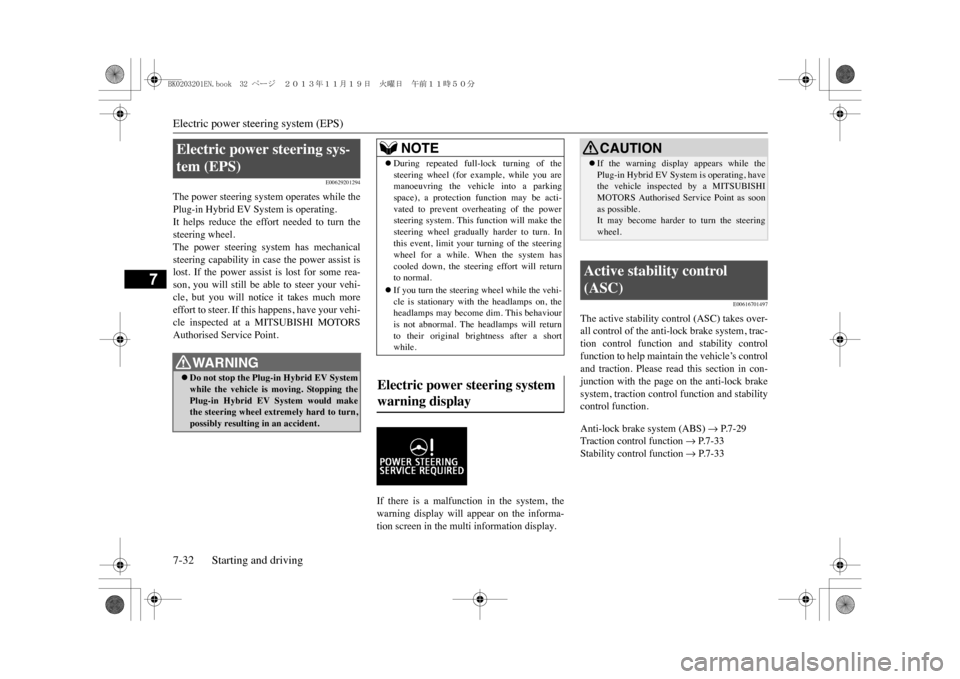
Electric power steering system (EPS)7-32 Starting and driving
7
E00629201294
The power steering system operates while thePlug-in Hybrid EV System is operating.It helps reduce the effort needed to turn thesteering wheel.The power steering system has mechanicalsteering capability in case the power assist islost. If the power assist
is lost for some rea-
son, you will still be able to steer your vehi-cle, but you will notice it takes much moreeffort to steer. If this happens, have your vehi-cle inspected at a MITSUBISHI MOTORSAuthorised Service Point.
If there is a malfunction in the system, thewarning display will appear on the informa-tion screen in the multi information display.
E00616701497
The active stability control (ASC) takes over-all control of the anti-lock brake system, trac-tion control function and stability controlfunction to help maintain the vehicle’s controland traction. Please read this section in con-junction with the page on the anti-lock brakesystem, traction control function and stabilitycontrol function.Anti-lock brake system (ABS)
�m P.7-29
Traction control function
�m P.7-33
Stability control function
�m P.7-33
Electric power steering sys-tem (EPS)
WA R N I N G�zDo not stop the Plug-in Hybrid EV Systemwhile the vehicle is moving. Stopping thePlug-in Hybrid EV System would makethe steering wheel extremely hard to turn,possibly resulting in an accident.
NOTE
�zDuring repeated full-lock turning of thesteering wheel (for example, while you aremanoeuvring the vehicle into a parkingspace), a protection function may be acti-vated to prevent overheating of the powersteering system. This function will make thesteering wheel gradually harder to turn. Inthis event, limit your turning of the steeringwheel for a while. When the system hascooled down, the steering effort will returnto normal.�zIf you turn the steering wheel while the vehi-cle is stationary with the headlamps on, theheadlamps may become dim. This behaviouris not abnormal. The headlamps will returnto their original brightness after a shortwhile.
Electric power steering system warning display
CAUTION�zIf the warning display appears while thePlug-in Hybrid EV System is operating, havethe vehicle inspected by a MITSUBISHIMOTORS Authorised Service Point as soonas possible.It may become harder to turn the steeringwheel.
Active stability control (ASC)
BK0203201EN.book 32 ページ 2013年11月19日 火曜日 午前11時50分
Page 226 of 388
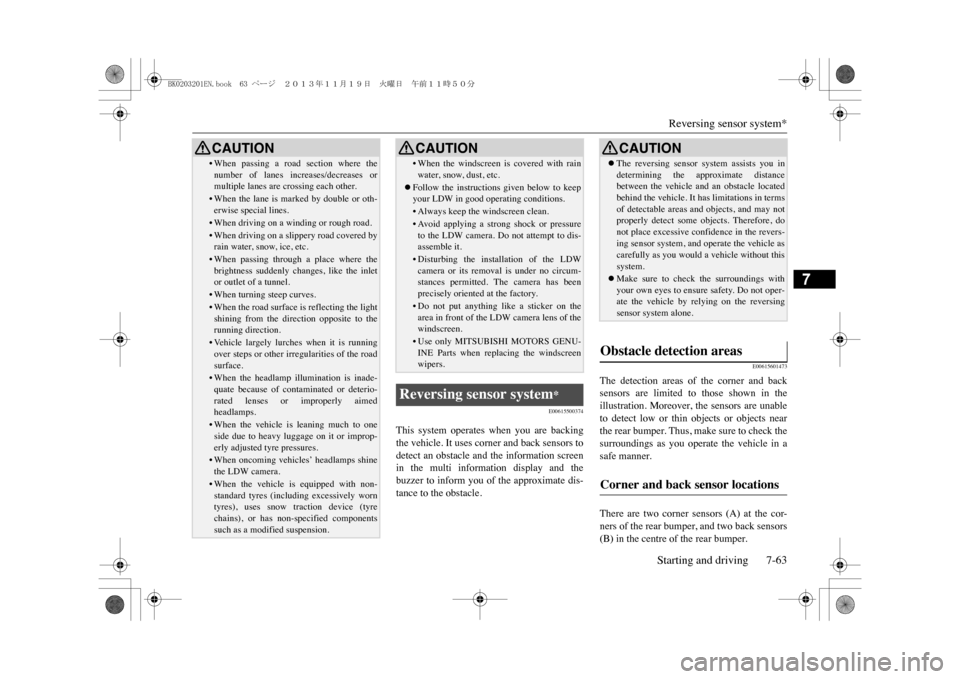
Reversing sensor system*
Starting and driving 7-63
7
E00615500374
This system operates when you are backingthe vehicle. It uses corner and back sensors todetect an obstacle and the information screenin the multi information display and thebuzzer to inform you of the approximate dis-tance to the obstacle.
E00615601473
The detection areas of the corner and backsensors are limited to those shown in theillustration. Moreover, the sensors are unableto detect low or thin objects or objects nearthe rear bumper. Thus, make sure to check thesurroundings as you operate the vehicle in asafe manner.There are two corner sensors (A) at the cor-ners of the rear bumper, and two back sensors(B) in the centre of the rear bumper.
•When passing a road section where thenumber of lanes increases/decreases ormultiple lanes are crossing each other.•When the lane is marked by double or oth-erwise special lines.•When driving on a winding or rough road.•When driving on a sli
ppery road covered by
rain water, snow, ice, etc.•When passing through a place where thebrightness suddenly ch
anges, like the inlet
or outlet of a tunnel.•When turning steep curves.•When the road surface is reflecting the lightshining from the direction opposite to therunning direction.•Vehicle largely lurches when it is runningover steps or other irregularities of the roadsurface.•When the headlamp illumination is inade-quate because of contaminated or deterio-rated lenses or improperly aimedheadlamps.•When the vehicle is leaning much to oneside due to heavy l
uggage on it or improp-
erly adjusted tyre pressures.•When oncoming vehicl
es’ headlamps shine
the LDW camera.•When the vehicle is equipped with non-standard tyres (incl
uding excessively worn
tyres), uses snow tr
action device (tyre
chains), or has non-specified componentssuch as a modified suspension.CAUTION
•When the windscreen is covered with rainwater, snow, dust, etc.
�zFollow the instructions given below to keepyour LDW in good operating conditions. •Always keep the windscreen clean.•Avoid applying a str
ong shock or pressure
to the LDW camera. Do not attempt to dis-assemble it.•Disturbing the installation of the LDWcamera or its removal is under no circum-stances permitted. The camera has beenprecisely oriented at the factory.• Do not put anything like a sticker on thearea in front of the LDW camera lens of thewindscreen.•Use only MITSUBISHI MOTORS GENU-INE Parts when replacing the windscreenwipers.
Reversing sensor system
*
CAUTION
CAUTION�zThe reversing sensor system assists you indetermining the approximate distancebetween the vehicle and an obstacle locatedbehind the vehicle. It has limitations in termsof detectable areas and objects, and may notproperly detect some objects. Therefore, donot place excessive confidence in the revers-ing sensor system, and operate the vehicle ascarefully as you would
a vehicle without this
system.�zMake sure to check the surroundings withyour own eyes to ensure safety. Do not oper-ate the vehicle by relying on the reversingsensor system alone.
Obstacle detection areas
Corner and back sensor locations
BK0203201EN.book 63 ページ 2013年11月19日 火曜日 午前11時50分
Page 231 of 388
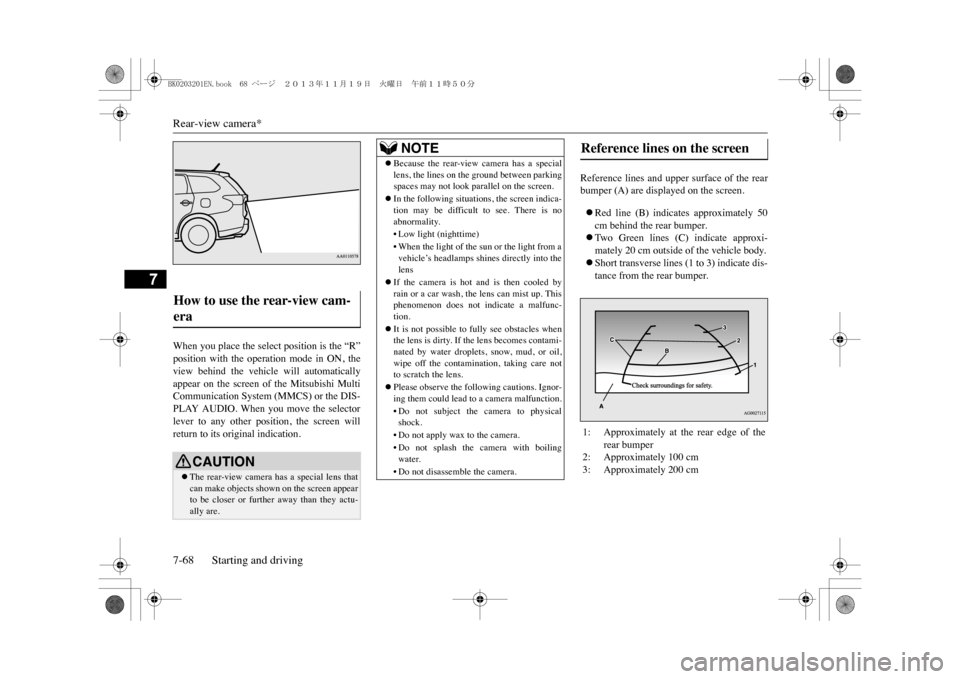
Rear-view camera*7-68 Starting and driving
7
When you place the select position is the “R”position with the operation mode in ON, theview behind the vehicle will automaticallyappear on the screen of the Mitsubishi MultiCommunication System (MMCS) or the DIS-PLAY AUDIO. When you move the selectorlever to any other position, the screen willreturn to its original indication.
Reference lines and upper surface of the rearbumper (A) are displayed on the screen. �zRed line (B) indicates approximately 50cm behind the rear bumper.�zTw o G r e e n l i n e s ( C ) i n d i c a t e a p p r o x i -mately 20 cm outside of the vehicle body.�zShort transverse lines (1 to 3) indicate dis-tance from the rear bumper.
How to use the rear-view cam-era
CAUTION�zThe rear-view camera has a special lens thatcan make objects show
n on the screen appear
to be closer or further away than they actu-ally are.
NOTE
�zBecause the rear-view camera has a speciallens, the lines on the
ground between parking
spaces may not look parallel on the screen.�zIn the following situations, the screen indica-tion may be difficult to see. There is noabnormality.•Low light (nighttime)•When the light of the sun or the light from avehicle’s headlamps shin
es directly into the
lens
�zIf the camera is hot and is then cooled byrain or a car wash, the lens can mist up. Thisphenomenon does not i
ndicate a malfunc-
tion.�zIt is not possible to
fully see obstacles when
the lens is dirty. If the lens becomes contami-nated by water droplets, snow, mud, or oil,wipe off the contamination, taking care notto scratch the lens.�zPlease observe the following cautions. Ignor-ing them could lead to a camera malfunction.•Do not subject the camera to physicalshock.•Do not apply wax to the camera.•Do not splash the camera with boilingwater.•Do not disassemble the camera.
Reference lines on the screen
1: Approximately at the rear edge of the
rear bumper
2: Approximately 100 cm3: Approximately 200 cm
BK0203201EN.book 68 ページ 2013年11月19日 火曜日 午前11時50分
Page 235 of 388
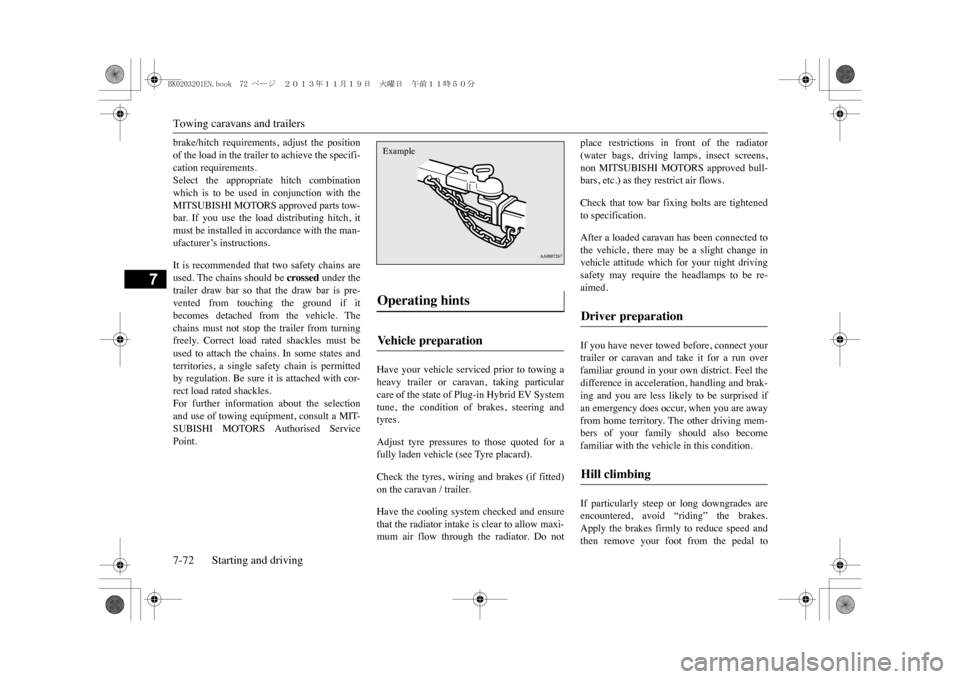
Towing caravans and trailers7-72 Starting and driving
7
brake/hitch requirements, adjust the positionof the load in the trailer to achieve the specifi-cation requirements.Select the appropriate hitch combinationwhich is to be used in conjunction with theMITSUBISHI MOTORS approved parts tow-bar. If you use the load distributing hitch, itmust be installed in accordance with the man-ufacturer’s instructions.It is recommended that two safety chains areused. The chains should be
crossed
under the
trailer draw bar so that the draw bar is pre-vented from touching the ground if itbecomes detached from the vehicle. Thechains must not stop the trailer from turningfreely. Correct load rated shackles must beused to attach the chains. In some states andterritories, a single safety chain is permittedby regulation. Be sure it is attached with cor-rect load rated shackles.For further information about the selectionand use of towing equipment, consult a MIT-SUBISHI MOTORS Authorised ServicePoint.
Have your vehicle serviced prior to towing aheavy trailer or caravan, taking particularcare of the state of Plug-in Hybrid EV Systemtune, the condition of brakes, steering andtyres.Adjust tyre pressures to those quoted for afully laden vehicle (see Tyre placard).Check the tyres, wiring and brakes (if fitted)on the caravan / trailer.Have the cooling system checked and ensurethat the radiator intake is clear to allow maxi-mum air flow through the radiator. Do not
place restrictions in front of the radiator(water bags, driving lamps, insect screens,non MITSUBISHI MOTORS approved bull-bars, etc.) as they restrict air flows.Check that tow bar fixing bolts are tightenedto specification.After a loaded caravan has been connected tothe vehicle, there may be a slight change invehicle attitude which for your night drivingsafety may require the headlamps to be re-aimed.If you have never towed before, connect yourtrailer or caravan and take it for a run overfamiliar ground in your own district. Feel thedifference in acceleration, handling and brak-ing and you are less likely to be surprised ifan emergency does occur, when you are awayfrom home territory. The other driving mem-bers of your family should also becomefamiliar with the vehicle in this condition.If particularly steep or long downgrades areencountered, avoid “riding” the brakes.Apply the brakes firmly to reduce speed andthen remove your foot from the pedal to
Operating hints Ve h i c l e p r e p a r a t i o n Example
Driver preparation Hill climbing
BK0203201EN.book 72 ページ 2013年11月19日 火曜日 午前11時50分
Page 348 of 388
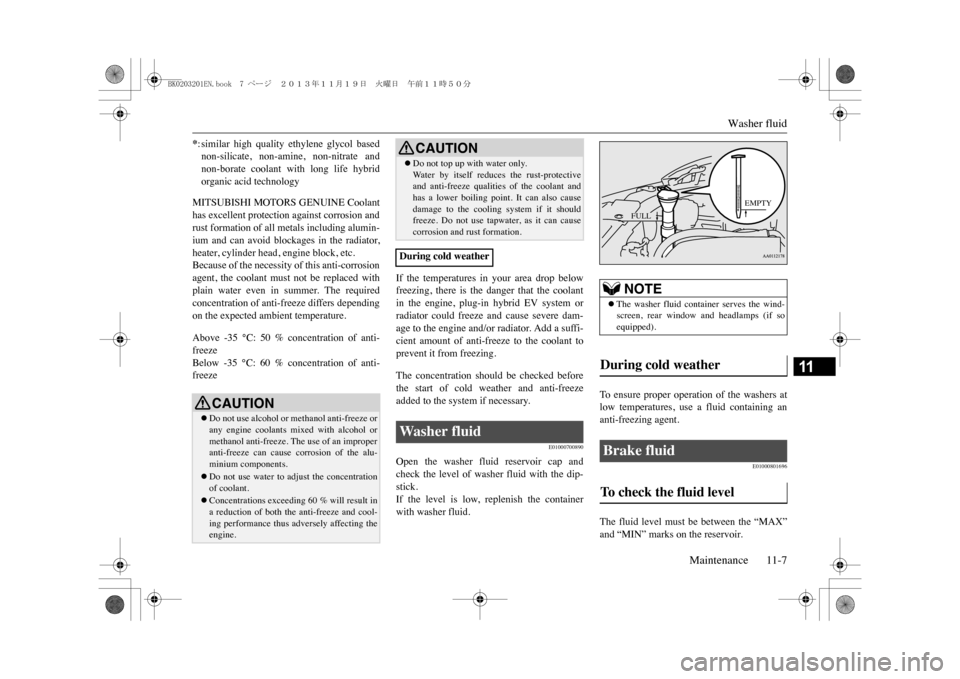
Washer fluid
Maintenance 11-7
11
MITSUBISHI MOTORS GENUINE Coolanthas excellent protection against corrosion andrust formation of all metals including alumin-ium and can avoid blockages in the radiator,heater, cylinder head, engine block, etc.Because of the necessity of this anti-corrosionagent, the coolant must not be replaced withplain water even in summer. The requiredconcentration of anti-freeze differs dependingon the expected ambient temperature.Above -35 °C: 50 % concentration of anti-freezeBelow -35 °C: 60 % concentration of anti-freeze
If the temperatures in your area drop belowfreezing, there is the danger that the coolantin the engine, plug-in hybrid EV system orradiator could freeze and cause severe dam-age to the engine and/or radiator. Add a suffi-cient amount of anti-freeze to the coolant toprevent it from freezing.The concentration should be checked beforethe start of cold weather and anti-freezeadded to the system if necessary.
E01000700890
Open the washer fluid reservoir cap andcheck the level of washer fluid with the dip-stick.If the level is low, replenish the containerwith washer fluid.
To e n s u r e p r o p e r o p e r a t i o n o f t h e w a s h e r s a tlow temperatures, use a fluid containing ananti-freezing agent.
E01000801696
The fluid level must be between the “MAX”and “MIN” marks on the reservoir.
*: similar high quality ethylene glycol basednon-silicate, non-amine, non-nitrate andnon-borate coolant with long life hybridorganic acid technologyCAUTION�zDo not use alcohol or methanol anti-freeze orany engine coolants
mixed with alcohol or
methanol anti-freeze. The use of an improperanti-freeze can cause corrosion of the alu-minium components.�zDo not use water to adjust the concentrationof coolant.�zConcentrations exceeding 60 % will result ina reduction of both the anti-freeze and cool-ing performance thus adversely affecting theengine.
�zDo not top up with water only.Wa t e r b y i t s e l f r e d u c e s t h e r u s t - p r o t e c t i v eand anti-freeze qualities of the coolant andhas a lower boiling point. It can also causedamage to the cooling system if it shouldfreeze. Do not use tapwater, as it can causecorrosion and rust formation.
During cold weatherWa s h e r f l u i d
CAUTION
NOTE
�zThe washer fluid container serves the wind-screen, rear window and headlamps (if soequipped).
During cold weather Brake fluid To c h e c k t h e f l u i d l e v e l
EMPTY
FULL
BK0203201EN.book 7 ページ 2013年11月19日 火曜日 午前11時50分
Page 360 of 388

Fuses
Maintenance 11-19
11
*: Fusible link�zSome fuses may not be installed on yourvehicle, depending on the vehicle modelor specifications.�zThe table above shows the main equip-ment corresponding to each fuse.
F7
Headlamp washer
20 A
F8
Security horn 20 A
F9
Horn 10 A
F10
ETV 15 A
F11 — — —F12
Engine 7.5 A
F13
ENG/POWER 20 A
F14
Fuel pump 15 A
F15
Ignition coil 10 A
F16 — — —F17
Headlamp high beam (left)
10 A
F18
Headlamp high beam (right)
10 A
F19
Head-lamp low beam (left)
Dis-charge
20 A
No.
Sym-bol
Electrical sys-
tem
Capacities
F20
Head-lamp low beam (right)
Dis-charge
20 A
F21
Head-lamp low beam (left)
Halo-gen
10 A
F22
Head-lamp low beam (right)
Halo-gen
10 A
F23 — — —#1 — Spare fuse 10 A#2 — Spare fuse 15 A#3 — Spare fuse 20 ANo.
Sym-bol
Electrical sys-
tem
Capacities
No.
Sym-bol
Electrical sys-
tem
Capacities
SBF1
Electrical Park-
ing Lock
30 A
*
SBF2
Va c u u m p u m p (Regenerative
brake)
30 A
*
F1
Water pump (Electric motor)
20 A
Sub fuse block
BK0203201EN.book 19 ページ 2013年11月19日 火曜日 午前11時50分
Page 362 of 388
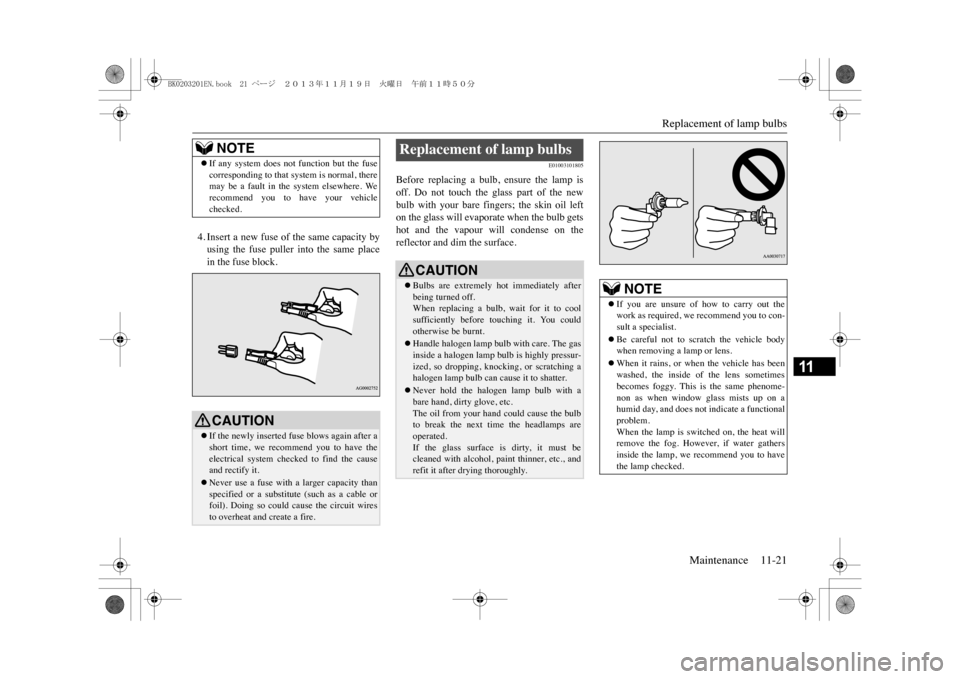
Replacement of lamp bulbs
Maintenance 11-21
11
4. Insert a new fuse of the same capacity byusing the fuse puller into the same placein the fuse block.
E01003101805
Before replacing a bulb, ensure the lamp isoff. Do not touch the glass part of the newbulb with your bare fingers; the skin oil lefton the glass will evaporate when the bulb getshot and the vapour will condense on thereflector and dim the surface.
NOTE
�zIf any system does not function but the fusecorresponding to that system is normal, theremay be a fault in the system elsewhere. Werecommend you to have your vehiclechecked.CAUTION�zIf the newly inserted fuse blows again after ashort time, we recommend you to have theelectrical system checked to find the causeand rectify it.�zNever use a fuse with a larger capacity thanspecified or a substitute (such as a cable orfoil). Doing so could cause the circuit wiresto overheat and create a fire.
Replacement of lamp bulbs
CAUTION�zBulbs are extremely hot immediately afterbeing turned off.When replacing a bulb, wait for it to coolsufficiently before
touching it. You could
otherwise be burnt.�zHandle halogen lamp bulb with care. The gasinside a halogen lamp
bulb is highly pressur-
ized, so dropping, knocking, or scratching ahalogen lamp bulb can cause it to shatter.�zNever hold the haloge
n lamp bulb with a
bare hand, dirty glove, etc.The oil from your hand could cause the bulbto break the next tim
e the headlamps are
operated.If the glass surface is dirty, it must becleaned with alcohol, paint thinner, etc., andrefit it after drying thoroughly.
NOTE
�zIf you are unsure of how to carry out thework as required, we
recommend you to con-
sult a specialist.�zBe careful not to scratch the vehicle bodywhen removing a lamp or lens.�zWhen it rains, or when the vehicle has beenwashed, the inside of the lens sometimesbecomes foggy. This is the same phenome-non as when window glass mists up on ahumid day, and does not
indicate a functional
problem.When the lamp is switched on, the heat willremove the fog. However, if water gathersinside the lamp, we
recommend you to have
the lamp checked.
BK0203201EN.book 21 ページ 2013年11月19日 火曜日 午前11時50分
Page 363 of 388
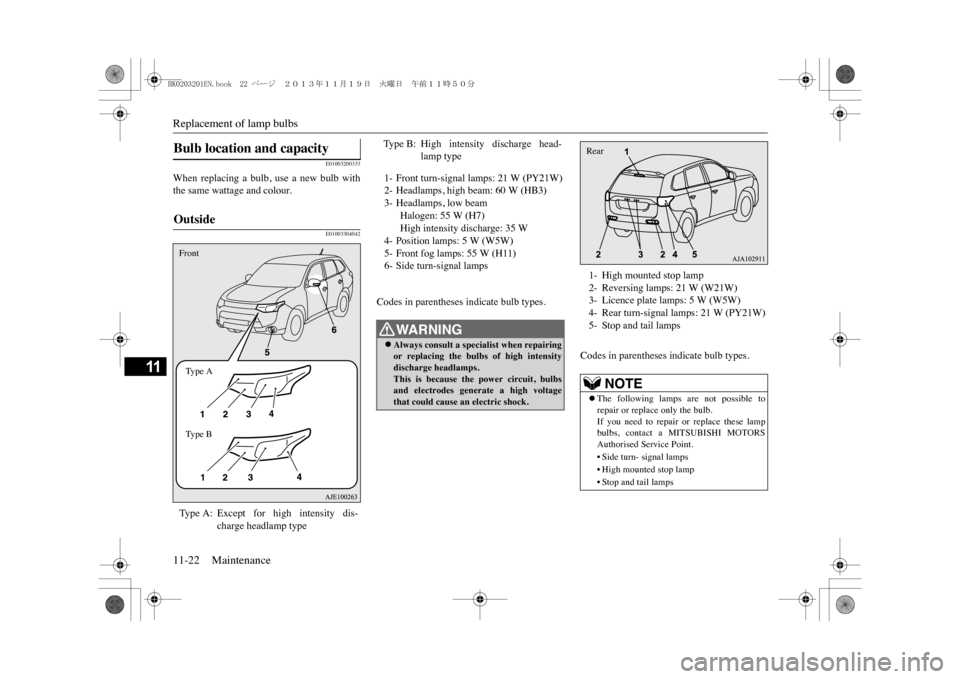
Replacement of lamp bulbs11-22 Maintenance
11
E01003200333
When replacing a bulb, use a new bulb withthe same wattage and colour.
E01003304042
Codes in parentheses indicate bulb types.
Codes in parentheses indicate bulb types.
Bulb location and capacity Outside Ty p e A : E x c e p t f o r h i g h i n t e n s i t y d i s -
charge headlamp type
FrontTy p e ATy p e B
Ty p e B : H i g h i n t e n s i t y d i s c h a r g e h e a d -
lamp type
1- Front turn-signal lamps: 21 W (PY21W)2- Headlamps, high beam: 60 W (HB3)3- Headlamps, low beam
Halogen: 55 W (H7)High intensity discharge: 35 W
4- Position lamps: 5 W (W5W)5- Front fog lamps: 55 W (H11)6- Side turn-signal lamps
WA R N I N G�zAlways consult a specialist when repairingor replacing the bulbs
of high intensity
discharge headlamps.This is because the power circuit, bulbsand electrodes generate a high voltagethat could cause an electric shock.
1- High mounted stop lamp2- Reversing lamps: 21 W (W21W)3- Licence plate lamps: 5 W (W5W)4- Rear turn-signal lamps: 21 W (PY21W)5- Stop and tail lamps
NOTE
�zThe following lamps are not possible torepair or replace only the bulb.If you need to repair or replace these lampbulbs, contact a MITSUBISHI MOTORSAuthorised Service Point.•Side turn- signal lamps•High mounted stop lamp•Stop and tail lampsRear
BK0203201EN.book 22 ページ 2013年11月19日 火曜日 午前11時50分